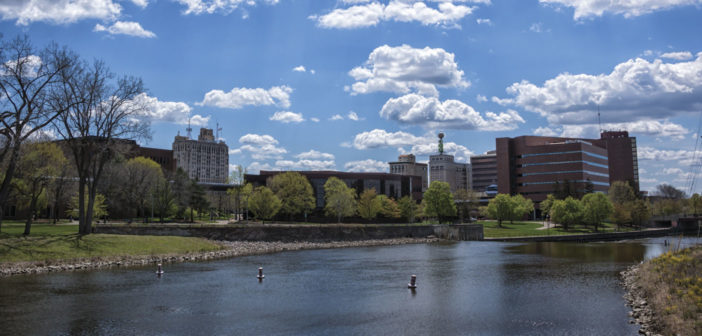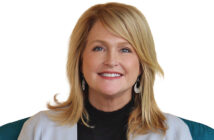| The travelers turn onto Saginaw St. from their I-69 exit. As they drive under the iconic Vehicle City arch and past pedestrians who fill the sidewalks and corners, they marvel at Flint’s beautiful buildings, art and culture. It is 2050, and the world has changed. In the distance, the north end’s wind turbines and vertical gardens shine in the midday sun. The travelers continue on, turning onto E. 2nd Street. As they pass the Capitol Theatre and enter the parking structure, they see their destination, the Flint Auditorium, rising across the plaza. It’s almost time for the show to start, but there is still time to visit the museums and shops. The travelers remember the stories their parents and grandparents would tell of a city on the edge – a city lost and forgotten, a relic of a time when industry polluted the air and waters and left whole populations behind in their conquest of profit. Now, everything is different. Flint is a cutting-edge city leading the way in art, culture and sustainability. The city is the comeback story of the century and a monument to the power of community, perseverance and hope. |
AS we enter the new ‘20s, Flint is starting to dream again. As the city continues to conquer our latest adversity, citizens are looking forward. What will the future bring for Flint? What will it look like? Where are we headed and how will we get there? Many in the city are optimistic and, for the first time since before the fall of General Motors, the future holds tremendous promise for Flint.
At the beginning of the ‘60s, Flint was booming. GM ruled the auto industry and jobs were plentiful. People flocked to the city from all over the world to get a piece of the pie making Flint the second largest city in Michigan. Leadership began to look forward, asking themselves, “What will Flint become? How can we sustain the momentum?” The potential for anything was held in their little pocket of time. The sky was the limit.
“We all need to nurture a sense of community that’s diverse and inclusive and welcomes everyone to be part of imagining our shared future.”
Ridgway White
In 1959, the City Council called on the city planning and consulting firm of Ladislas, Segoe & Associates from Cincinnati, OH to assemble a Master Plan for the future. The 300-plus-page report compared Flint to other cities of the same size and industry around the nation. Flint graded well – it was forecasted that its trajectory would continue upward in earning, industry, arts, recreation, population and potential. (With caveats such as better industry diversification and new transportation routes).
The consulting firm planned additional streets and thoroughfares. They pushed for more parks such as a Clio-Dupont Park in the north, a new Mt. Morris Park, a Genesee-Belsay Park in the east and a Hammerberg Road Park in the south. With the forecasted population, they advised two additional high schools. They looked to widen streets and add more “street trees.”
In order to enhance the Saginaw St. Business District, they recommended removing Saginaw St. altogether in order to create a large, walking pedestrian mall. This plan would have made Flint a business and shopping mecca, attracting people from miles around and to improve accessibility, they plotted the route of I-475 through the city. (The planners’ initial route is very different than the final. GM was the driving force behind I-475, as they wanted it for ease of trucking of parts and vehicles. After GM intervened, the route was changed.)
As the plans began to be implemented, Flint began to falter. Both the Master Plan and John F. Kennedy, during a campaign speech at Atwood Stadium, warned that industry diversification was needed if Flint was to survive and continue its strength. The warnings either came too late or went unheeded. The ‘70s oil embargo started the long, slow fall of GM as foreign, more-economic vehicles made an impact. GM lost market share and Flint lost jobs. The majority of the 1960s plan put forth by Ladislas, Segoe & Associates never came to fruition and the only major lasting change – I-475 – did increase traffic flow, but further divided the city along racial lines. Visions of the future evaporated as citizens began to worry about survival. The dreams of the early ‘60s were lost.
“The greatest challenge ahead of us is developing a system to best utilize the assets of our amazing institutions; private, non-profit and municipal. This entails a cohesive effort to maximize their impact so that every resident of Flint enjoys the benefits.”
Gerard Burnash
More than five decades later, Flint dared to think forward, once again. In 2013, Flint adopted a new Master Plan. This time, the idea was not to make Flint a leading Midwestern city, but a more sustainable one. Flint was under State control and while decisions were being made by Lansing’s number crunchers, city leadership decided to move forward on their own. The 2013 Imagine Flint Master Plan presented a city that was smaller and more industrially diversified.
The plan dared to look past GM and the auto industry, featuring education, the healthcare industry and sustainable energy as opportunities for success. Reliable infrastructure, neighborhood development, civic life, enhanced green space, social equity and cultural compassion were all determined integral to survival. The plan envisioned a robust Downtown with business opportunity, room for more pedestrian traffic and “street trees.” After blight removal, homes would be surrounded by beautiful gardens, only a short walk from a community center that provides all the goods needed for health and happiness. State-of-the-art production areas and green innovation centers would provide local communities with jobs and support. New, affordable housing complexes would dot the land in strategic locations.
Flint was to be more compact, greener and more economical; the city was ready to embrace its assets. The future was again on everyone’s mind. People got to work only to be interrupted, yet again, by adversity as the water crisis hit and Flint made all the national headlines. The city was painted with despair, but its residents responded in a big way. They fought for their rights and as they did, city leaders decided to move forward, regardless. The Master Plan was put into effect Downtown. Flint wasn’t waiting for the perfect time to grow anymore. The city was going for progress and weathering the storms that came during the process. Organizations sprang up to breathe life into the plan. Vacant land became gardens, new housing was built, blight was removed, the city began its renaissance. Citizens didn’t have time to wallow in the past, as the future could no longer be ignored. The city embraced music, arts and culture, diversity and intelligence. It embraced new ideas, pastimes and beliefs. A new confidence was cultivated. Flint began to rely not on outside governments or companies, but on itself – as the creator of its future, for better or worse.
In 2019, the city took its next step when the Downtown Development Authority (DDA) revealed the newest game plan for the heart of the city with a focus on enhancement of the Saginaw St. Corridor and Flint River areas. The new Downtown will feature a central park with a riverfront connection through the UM-Flint Campus. Saginaw St. will be placed on a “diet,” which will reduce it to two lanes in places with larger pedestrian walkways and more parking with the addition of the fabled “street trees” of plans past. The rest of Downtown’s one-way streets will be converted to two-way streets. These include Church, Beach, Harrison and Wallenberg. New streets will be built for better traffic flow and old streets (such as Wallenberg and University) will be extended.
“We are educating a new generation of change agents who will lead this community into an exciting era. Flint and its leaders did it once, and it will do it again by 2050.”
Debasish Dutta
The plan looks to replace W. First Ave. between Saginaw and Grand Traverse with a pedestrian promenade overlooking a new waterfront park that will be built between the Riverfront Garage and Chevy Commons and will include a signature playground.
The north parking lot owned by UM-Flint will hold brand-new field sports venues for inter-collegiate, intramural and public use. (Not to mention the extension of Berston Field House and the new sports complex to be built at Sylvester Broome Empowerment Village). According to the plans, Saginaw and E. 2nd Streets will become the centerpoint of a new entertainment district featuring more spaces for foot traffic, shopping and a brand-new, large arts and entertainment venue.
In order to free up even more business space, plans are in the works to consolidate the municipal buildings into one large complex in the area of the current City Hall, making Saginaw St. more attractive to travelers and entrepreneurs. Many plan items are already in the works and set to be completed by 2022 with the majority of the plan being finished in 2027. The future is on its way.
While the outside world continues to look at Flint as a forlorn and dying city, Greater Flint has changed its view to one of hope. The city is becoming a surprising destination for artists and musicians. It is welcoming new ideas and cultures and new green industries are beginning to pay attention to our once forgotten city. The people of Flint are embracing the future and the city’s potential is ours to shape.
As time moves forward, My City Magazine asks, “What do YOU see for the future of Flint?” We reached out to community leaders for their thoughts.
Community Leaders
Gerard Burnash
Executive Director, Flint Downtown Development Authority
Debasish Dutta
Chancellor, UM-Flint
Harold Hill
Operations Manager, Greater Flint Arts Council
Adil Mohammed
Co-Founder, International Center of Greater Flint
Executive Director, American Muslim Community Services
Isaiah M. Oliver
President and CEO, Community Foundation of Greater Flint
Costa Papista
President, Flint City Bucks FC
Maryum Rasool
Executive Director, Sylvester Broome Empowerment Village
Phyllis Sykes
Executive Director/Co-Founder, International Center of Greater Flint
Raquel Thueme
President, Ruth Mott Foundation
Beverly Walker-Griffea
President, Mott Community College
Ridgway White
President and CEO, C.S. Mott Foundation
Shannon Easter White
Architect/Owner, FUNchitecture
Owner/Buyer, SHIFT
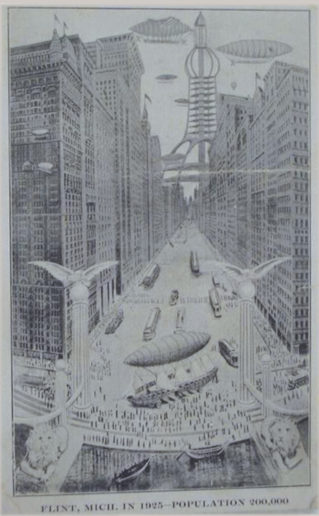
A postcard from 1920 predicting how Flint would look in 1925, just five years later.
Describe the City of Flint in 2030, 2050.
Debasish Dutta: Over the next decade, the City of Flint will continue its strong trajectory. This is a community that gets things done through strong collaborative efforts, and the University of Michigan-Flint will be a steadfast partner. The city will resolve the remaining issues around the water crisis. It will attract new businesses and expand beyond the education and healthcare industries. We will see our neighborhoods strengthened, as well as the Flint Community Schools. Just as Flint was at the forefront of new technology at the turn of the 20th century with the birth of the automotive industry, by 2030, Flint will find its footing in the 21st century global economy through new technology industries and an innovative technology park, possibly on University Avenue. We are educating a new generation of change agents who will lead this community into an exciting era. Flint and its leaders did it once, and it will do it again by 2050.
Adil Mohammed: 2030: Lessons learned from the water crisis must re-make the city to be a leading example of how to prepare and be ready to tackle the next crisis that will inevitably come. Work to create a stable political environment founded on trust. Imagine Flint vision implementation in full force. 2050: Flint is a destination place (top three in the state) for domestic migration (within the U.S.).
Isaiah M. Oliver: Downtown Flint of the future is a magnet for people throughout Genesee County, a vibrant, family-friendly city filled with restaurants, shopping and entertainment for people of all ages. The Flint River meanders through the City, a symbol of rebirth and hope that offers recreational opportunities for kayakers, canoers and fishermen. Festivals and events continue to be a big draw, particularly, longstanding traditions like Back to the Bricks and the Crim Festival of Races. Our Downtown streetscape has been renewed, with main water lines replaced and the red bricks of Saginaw Street renovated to their original glory. Our neighborhoods are vibrant and there is evidence of an equitable distribution of financial and social capital throughout the city. In all, Flint is perfect for us. All of us.
Maryum Rasool: My vision for 2030 is simple: neighborhoods without blight, access to clean water and nutritious food, a just and equitable city for all, and the street is the dominant location for public life, as well as transportation. In 2050: the above times five.
Phyllis Sykes: There will be clean water, smaller, yet thriving and diverse neighborhoods, a state-of-the-art public school system, cohesive city governance working in partnership with the out-county areas, bustling riverfront development and a hip, eclectic and artsy downtown area. In 2030 and 2050, the City of Flint will be unrecognizable.
Raquel Thueme: In 10 years, and still in 30 years, Flint will be known as a resilient city that has faced adversity and come out stronger. I hope to see more people living and working here, improved outcomes for our children and families, small business growth and thriving neighborhoods.
Beverly Walker-Griffea: In 2030, the City of Flint will have more residents with a college credential working in high-demand, high-paying jobs. There will be less of a health and wellness gap by ZIP code, less stressors and less crime. Our residents will be poised for an economic renaissance and will demand a renewed focus on providing social, cultural, artistic and intellectual offerings.
Vibrancy! Excitement! A city that is alive with creativity, innovation and future-forward thinking! By 2050, the city of Flint will be the role model for successful post-industrial urban revitalization. Local college partnerships will strive to offer credentials in unique ways that lead to high-paying jobs. Great career opportunities, entrepreneurship spaces and visionary minds will drive a robust local economy. A multitude of diverse industries will compete to have offices in Flint due to the excellent educational, transportation, artistic, cultural and skilled talent offerings.
Ridgway White: Every new decade will bring its opportunities and challenges. By 2030, I think the re-imagined Flint River waterfront will change how people view and experience the river and our city. It will be a very visible representation of the importance of protecting our natural resources, promoting quality of life for residents and looking for new ways to bring people to Flint.
At the same time, we’re likely to be living with changes made to address the preceding decades of population loss and a shrinking tax base. For instance, it’s likely that the City of Flint, Genesee County and several major school districts will consolidate some resources. If this is done well, people’s access to combined resources should help to create more equity of opportunity across the region.
Beginning now and continuing through 2050, concerns about climate change are likely to make Flint and the entire Great Lakes region a more attractive place for people to live and work. As the planet’s single largest source of surface freshwater, the Great Lakes will draw individuals and companies looking for a more sustainable future.
But it’s not just the water in the lakes that’s important. Because our community has experienced the Flint water crisis, I believe we’ll have not only best practices in water treatment and filtration, but also a comprehensive approach to dealing with drinking water, wastewater and storm water. Flint will be a place where we look at water from source to sink to ensure that we have abundant, safe water. Three decades from now, when people hear the name Flint, they won’t just think of our water crisis, but of water solutions. They’ll know that, even as the city struggled to recover, we also went on to help solve some of our nation’s most pressing challenges related to water quality and affordability.
Finally, the ways in which people work will be drastically different by 2050. Opportunities to thrive in that new work force – and at the same time enjoy good health and quality of life – will be influenced by the success of Flint’s colleges and universities, health and wellness centers, and nonprofit organizations. Wearing my amateur futurist’s hat, I predict that we’ll no longer be commuting to offices in 2050. But, if we are, I think massive uptake of autonomous driving will create a mega-region that’s anchored by Detroit, Lansing, Ann Arbor and Flint.
Shannon Easter White: Diverse, vibrant, bustling – with a larger student, residential and business population to support Downtown businesses. In 2050: walkable, with trails, bike paths, the Flint River as a hoppin’ destination with an arts community of galleries – like Asheville, NC – along the river (where the old Chevy in the Hole site is, near Kettering.)
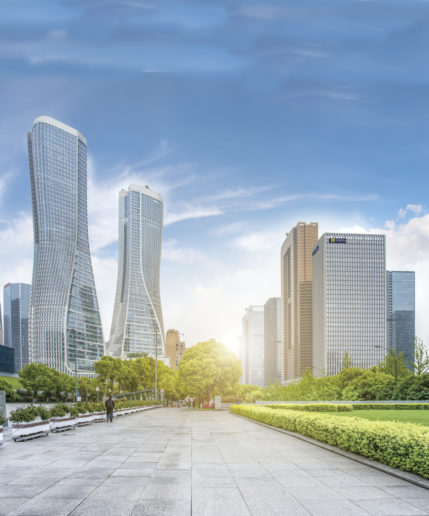
A picture of potential. Is this the future of Flint? The sky is the limit.
If you could make one thing happen in the next 12 months, what would it be?
Gerard Burnash: Upgrade the streetscapes in Downtown Flint to be more pedestrian friendly, with improved landscaping and amenities. Harrison and Beach Streets would be converted to two-way traffic with “tree islands” down the center, angled parking on Saginaw St. with bump-outs at crosswalks, new sidewalk trees with proper drainage and watering systems, and smart street-lighting. If we’re dreaming big, convert Second St. between Saginaw and Harrison into an Urban Plaza with automatic bollards at each end for daytime and evening programming, especially during events at The Capitol Theatre.
Debasish Dutta: In the next 12 months, we will make significant progress on the establishment of our new School of Technology. It will be only the second such school in the state of Michigan. As such, it will attract more students to Flint so they can enroll in this cutting-edge school, with curriculum designed to help them attain careers in technology and related fields. These students will lead the way, with the knowledge and skills needed to deal with realities of cyber security, mobility, healthcare technologies, environment and sustainability, and more. The new School of Technology will be a game-changer for the campus, the community and Michigan.
Isaiah M. Oliver: I would ensure that Flint and Genesee County have 100 percent participation in the 2020 Census. I’d also be hopeful we would begin intentionally building relations within and across racial groups.
Costa Papista: We would love to deliver another winning soccer season and National Championship to the city of Flint in 2020!
Maryum Rasool: Complete the SBEV Flint Sports complex.
Phyllis Sykes: Facilitate an action plan to create a collegiate city council.
Raquel Thueme: I’m going to bend the rules in the name of community revitalization and list two things: 1. A complete 2020 census count for Flint so we don’t lose key federal funds, and 2. The state of Michigan addresses inequities in K-12 education funding and revenue sharing with cities. We need these things to happen for the sake of our community.
Ridgway White: The community would come together to develop and adopt a plan for re-imagining the entire education continuum in Flint, with special emphasis on strengthening K-12 public education to serve all Flint kids.
Shannon Easter White: Finish construction of new housing Downtown and in north Flint, open the new hotel, and have some dynamite shows at the Capitol or Cultural Center institutions that bring loads of fresh faces, dollars and revenue to our local businesses!
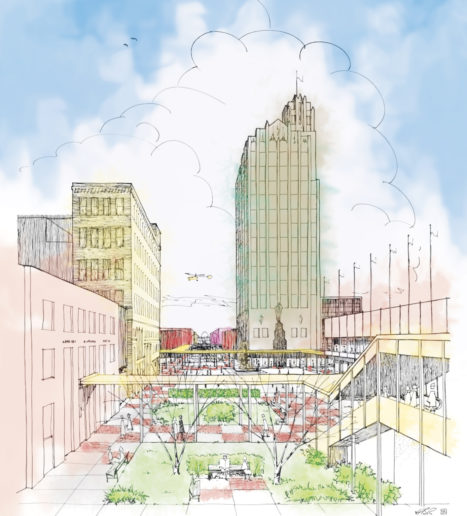
Courtesy of HathiTrust
The 1960 master plan paints Saginaw st. as a vibrant, urban plaza. This conceptual drawing presents the view looking east toward the Mott Foundation Building on First st.
What are Flint’s biggest challenges and how do we overcome them?
Gerard Burnash: The greatest challenge will be developing a system to best utilize the assets of our amazing institutions – private, non-profit and municipal. This entails a cohesive effort to maximize their impact so that every Flint resident enjoys the benefits.
Debasish Dutta: As an engineer, I see infrastructure as a big challenge in Flint and around the country. There are many types of infrastructure, roads and bridges that must be replaced. Near our campus, replacing the crumbling Hamilton Dam a few years ago was an important step for both the University and community. The aging electrical grid in this country has left the U.S. vulnerable to outages and even cyber attacks. The way to solve any challenge is through knowledge. That is why our contribution will be education, and specifically adding the School of Technology to address these global 21st century issues.
Harold Hill: Fix the public schools. Bring driver education back to public schools along with training in the trades, i.e. wood shop, auto repair, plumbing, electrical. The biggest challenge is K-12 education. Public school deficit can’t be overcome – something needs to be done besides cutting expenses. Change the formula for allocating funds for special education. Lottery money should be given in addition to the amount schools get from their general budget allocation. It is now subtracted from it. There also is a shortage of housing, especially newer homes – need to encourage new development. Plenty of land available, i.e. where schools have been torn down or closed, Clark Elementary, Cody, etc. Create critical mass of housing around the city center to strengthen Downtown and create small business opportunities in clusters to provide services.
Isaiah M. Oliver: In the recent State of Flint Kids report, we learned that 69 percent of our children under the age of five live in poverty, compared to 26 percent in Michigan. Workforce development, job training and apprenticeship programs, and the Flint Promise educational program are all pathways to employment and earning a livable wage. Full employment will help lift our children out of poverty so that they can reach their full potential.
Costa Papista: I believe that perception is one of the biggest challenges. Once people actually see Downtown and the great assets that Flint and Genesee have to offer, any negative perceptions evaporate. We have seen this firsthand with our players, their family members, visiting teams, coaches and fans. Everyone has been extremely impressed with what they’ve seen in Flint.
Maryum Rasool: We are failing our young adults/youth. We have to position them to have all the tools needed to impact the world. Each individual has a unique talent, gift and passion. It is our duty as community leaders and community members to ensure that our youth have every opportunity to not only dream, but also cultivate their passion.
Raquel Thueme: Flint has a great need for a stronger economic and educational infrastructure for families, requiring jobs, sufficient tax base and funding, and strong public education system(s).
Beverly Walker-Griffea: Our biggest challenge is working together as a community. We are easily fractured and siloed in our own quests to make Flint a better place. We sometimes will not listen, or concede, or give an idea a fair chance. Our biggest journey will be to learn how to lay down our vulnerabilities and develop trust so that we can work together for the betterment of Flint and not our own personal mantras.
Ridgway White: Childhood poverty is Flint’s biggest challenge. To help families break the grip of poverty and seize opportunity, we need to strengthen Flint’s entire education continuum – from cradle to college and career training.
Shannon Easter White: Division by race – we must continue working hard on diversity, inclusion and racial healing. We must have more opportunities and healing events that bring ALL colors and backgrounds together peaceably for the collective good.
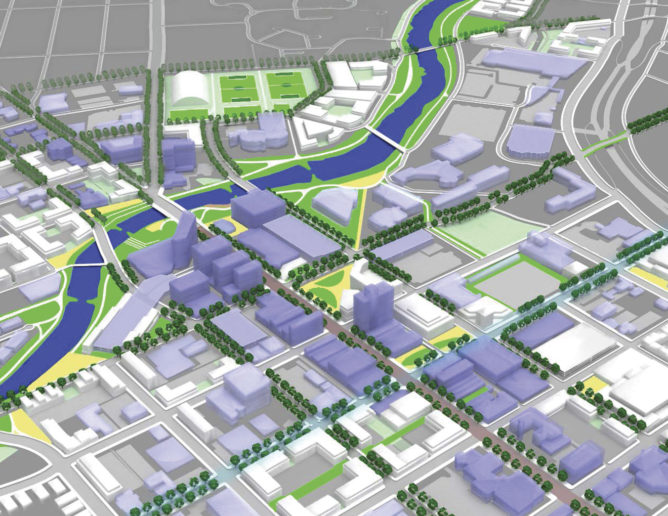
Schematic plan of Downtown from the newest DDA plan. Existing structures are in blue and gray, proposed structures in white. Note the location of a new sports complex across the river and new downtown parks.
What role will your organization play in Flint’s future?
Gerard Burnash: The DDA will continue assisting with event planning and promotion, parking management, general maintenance and beautification through landscaping to create a fun and welcoming atmosphere in Downtown Flint for all to enjoy.
Debasish Dutta: UM-Flint will continue to be an anchor institution, partnering with other institutions for the common good. We will continue to be a leading educational resource for the local community, with an expanded student population from across the country and around the world. UM-Flint’s role in Flint’s future will be no less than Stanford and Berkeley’s role in creating the Silicon Valley decades ago.
Harold Hill: GFAC will continue to promote and develop opportunities for artists and art projects, campaigning for reinstating art programs in public schools, filling the void in entertainment and cultural opportunities.
Isaiah M. Oliver: The Community Foundation of Greater Flint will partner and lead by influencing and connecting generosity to Genesee County needs. We envision our continued role as a funder and community partner focused on a vibrant and equitable Genesee County where everyone can thrive.
Costa Papista: The Flint City Bucks will contribute by helping to create a vibrant, cool, future-focused city that attracts and retains the best and the brightest! We will strive to be a summer sports and entertainment destination asset for Downtown Flint and the entire community for years to come.
Maryum Rasool: We are here to do whatever it takes to support our youth and their families. We strive to make Flint the great, robust city that it once was. No one single organization can do this alone. It is not a competition, it is a collaboration of community partners striving to meet one goal, one mission – and that is to win for Flint. When one organization wins, we’ve all won! Flint is fearless. We are not just impacting Flint for the next three years, but for the next 100 years to come, creating a legacy that will change the world.
Phyllis Sykes: ICGF’s mission is to create an environment/city that is welcoming to all people. Years ago, we had the International Institute, a valuable resource in our community that served as the go-to place for all things pertaining to global issues. ICGF is filling that void in our community. Our mission is to be of service to ALL native and foreign-born residents, and to celebrate the diversity of our community.
Raquel Thueme: The Ruth Mott Foundation will continue to partner and work with residents in a meaningful way to improve quality of life for families and make Flint a vital and enriching place for all.
Beverly Walker-Griffea: Mott Community College is an anchor institution in this community and has played a unique role for almost 100 years to support the sustainability of Flint. Throughout Flint’s history, MCC has served this community as a stable foundation and safe haven. MCC will continue to support Flint by offering outstanding academic credentials that lead to high-paying jobs, support services that help students complete, an economic engine that is a great talent pipeline for business, and an intellectual space for community members’ lifelong learning endeavors. MCC is Flint and Genesee County’s community college and will continue to lead the efforts to improve the economic and social fabric of the region.
Ridgway White: We’ve been in Flint since C.S. Mott established our foundation almost 100 years ago, and we’ll continue to help our community respond to opportunities and challenges that arise. I know there’s still a lot of work to be done right now, particularly to revitalize a strong K-12 public education system. I’m determined that we will not rest until all children in Flint have the opportunity to reach their full potential. It’s an ambitious goal – one we can’t achieve without a similar commitment from many partners across all sectors. But I can promise that it will remain a focus for the Mott Foundation.
Shannon Easter White: FUNchitecture will continue thinking outside of the box – literally! – creatively solving problems of space, architecture, brand and design with strategically fun and innovative solutions.
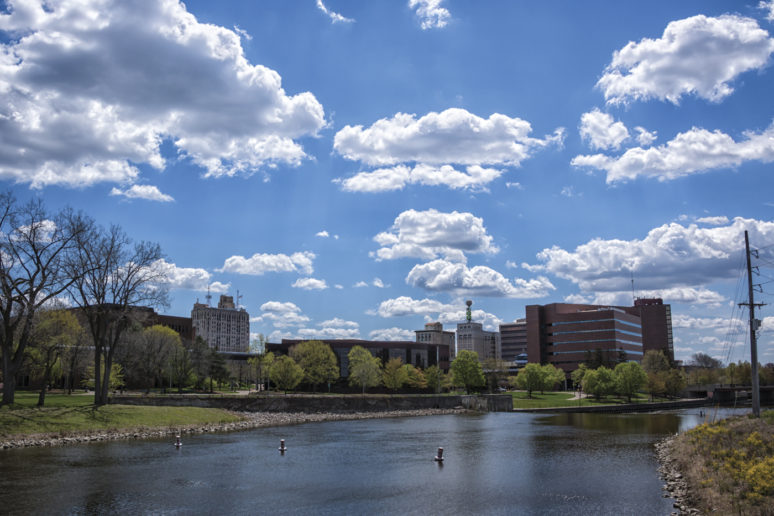
What one thing/innovation/movement will have the greatest influence on Flint in the coming decade?
Debasish Dutta: The global movement toward sustainability will impact us all. In Flint, finding ways to nurture our natural resources for the sake of the economy and the planet will make a difference. At UM-Flint, we are already at work on this future movement with such initiatives as our Green Chemistry program. It is the only undergraduate degree of its kind in the United States, and it is preparing the next generation of scientists to deal with such issues as PFAS, life-cycle engineering, toxicology and public policy. It is a revolutionary program, that has great potential to alter the future for the collective good.
Gerard Burnash: Our expectation is that the progress happening Downtown continues to spill over into the surrounding neighborhoods and business districts. New opportunities for entrepreneurs, better outdoor recreation through walking and biking trails and parks, and increased housing options for all residents. A great deal of investment has been made to stabilize Flint’s Downtown core; now we want to see that trend continue up ML King and Saginaw, east and west via Court Street and University Drive, and south down Saginaw Street past the expressway.
Harold Hill: We are still dealing with systemic racism and social justice issues. I see a widening of the gap. Big mistake putting a public housing project on N. Saginaw and Louisa area. The licensing of recreational marijuana facilities will be a problem if there are none minority-owned.
Adil Mohammed: Flint needs to decide what its “flag” is, and deliberately, intentionally pursue it. We are not a “vehicle city” anymore. That’s our history, but not necessarily the future. Go Blue (water technologies) and Go Green (renewable energy technologies).
Isaiah M. Oliver: Equity is a movement, a way forward that begins by joining together, believing in the potency of inclusion and building from a common bond. We are focused on equity, truth, racial healing and transformation – changing the narrative so we can jettison the hierarchy of human value and come together in our common humanity. It demands honesty and forthrightness, calling out racism and oppression, both overt and systemic.
Maryum Rasool: Restoring the renowned Mott community education model throughout the city of Flint, which impacted so many lives and supported their dreams, giving the youth a safe place to cultivate and grow. This is an experience, a movement of community and infusion of passion and life back into our young adults who have lost hope.
Phyllis Sykes: With the threat of a “brain drain” in our community, initiate a community-wide effort to engage and mentor our youth to strategize on how to rebrand the city, and create a plan that would attract other youth and internationals to make Flint their home.
Raquel Thueme: A diverse economic base with thriving small businesses that are hiring flint youth and adults. One of Flint’s greatest strengths is its wonderful mix of strong, skilled, persistent residents who are steadfast in their resolve to stay here and build a better future.
Beverly Walker-Griffea: Flint’s citizens working together, listening to each other, planning with each other and making good decisions together for the city will be the greatest step that we could make as a community.
Ridgway White: While there’s no single solution for moving a community forward, I think a sense of community is the most important ingredient for making progress. We all need to nurture a sense of community that’s diverse and inclusive and welcomes everyone to be part of imagining our shared future.
After all the city and its populace has gone through, Flint is ready to take a big step in the right direction. The community must unite from all areas, and work to create a bright future for all Flint citizens. It’s all up to us, for better or worse.
What is YOUR vision of Flint’s future?



